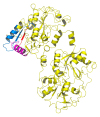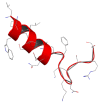Antimicrobial Activity of Lactoferrin-Related Peptides and Applications in Human and Veterinary Medicine
- PMID: 27294909
- PMCID: PMC6273662
- DOI: 10.3390/molecules21060752
Antimicrobial Activity of Lactoferrin-Related Peptides and Applications in Human and Veterinary Medicine
Abstract
Antimicrobial peptides (AMPs) represent a vast array of molecules produced by virtually all living organisms as natural barriers against infection. Among AMP sources, an interesting class regards the food-derived bioactive agents. The whey protein lactoferrin (Lf) is an iron-binding glycoprotein that plays a significant role in the innate immune system, and is considered as an important host defense molecule. In search for novel antimicrobial agents, Lf offers a new source with potential pharmaceutical applications. The Lf-derived peptides Lf(1-11), lactoferricin (Lfcin) and lactoferrampin exhibit interesting and more potent antimicrobial actions than intact protein. Particularly, Lfcin has demonstrated strong antibacterial, anti-fungal and antiparasitic activity with promising applications both in human and veterinary diseases (from ocular infections to osteo-articular, gastrointestinal and dermatological diseases).
Keywords: antimicrobial peptides; food safety; lactoferricin; milk proteins.
Conflict of interest statement
Candioli Farmaceutici is the funding sponsor in writing the manuscript.
Figures
Similar articles
-
Bovine and human lactoferricin peptides: chimeras and new cyclic analogs.Biometals. 2014 Oct;27(5):935-48. doi: 10.1007/s10534-014-9753-4. Epub 2014 Jun 11. Biometals. 2014. PMID: 24916114
-
Lactoferrin and Peptide-derivatives: Antimicrobial Agents with Potential Use in Nonspecific Immunity Modulation.Curr Pharm Des. 2018;24(10):1067-1078. doi: 10.2174/1381612824666180327155929. Curr Pharm Des. 2018. PMID: 29589540 Review.
-
Lactoferrin: an iron-binding antimicrobial protein against Escherichia coli infection.Biometals. 2011 Aug;24(4):585-94. doi: 10.1007/s10534-011-9423-8. Epub 2011 Feb 16. Biometals. 2011. PMID: 21327478 Review.
-
Lactoferrin and Its Derived Peptides: An Alternative for Combating Virulence Mechanisms Developed by Pathogens.Molecules. 2020 Dec 8;25(24):5763. doi: 10.3390/molecules25245763. Molecules. 2020. PMID: 33302377 Free PMC article. Review.
-
Lactoferrin-derived peptides and Lactoferricin chimera inhibit virulence factor production and biofilm formation in Pseudomonas aeruginosa.J Appl Microbiol. 2010 Oct;109(4):1311-8. doi: 10.1111/j.1365-2672.2010.04751.x. Epub 2010 Aug 19. J Appl Microbiol. 2010. PMID: 20477900
Cited by
-
Nutraceuticals and Dietary Supplements for Older Adults with Long COVID-19.Clin Geriatr Med. 2022 Aug;38(3):565-591. doi: 10.1016/j.cger.2022.04.004. Epub 2022 Jun 20. Clin Geriatr Med. 2022. PMID: 35868674 Free PMC article. Review.
-
Natural Antimicrobial Peptides as Inspiration for Design of a New Generation Antifungal Compounds.J Fungi (Basel). 2017 Aug 26;3(3):46. doi: 10.3390/jof3030046. J Fungi (Basel). 2017. PMID: 29371563 Free PMC article. Review.
-
In silico investigation and potential therapeutic approaches of natural products for COVID-19: Computer-aided drug design perspective.Front Cell Infect Microbiol. 2022 Aug 22;12:929430. doi: 10.3389/fcimb.2022.929430. eCollection 2022. Front Cell Infect Microbiol. 2022. PMID: 36072227 Free PMC article. Review.
-
Characterization of Antimicrobial Composite Edible Film Formulated from Fermented Cheese Whey and Cassava Peel Starch.Membranes (Basel). 2022 Jun 20;12(6):636. doi: 10.3390/membranes12060636. Membranes (Basel). 2022. PMID: 35736343 Free PMC article.
-
Tryptophan-Rich and Proline-Rich Antimicrobial Peptides.Molecules. 2018 Apr 2;23(4):815. doi: 10.3390/molecules23040815. Molecules. 2018. PMID: 29614844 Free PMC article. Review.
References
Publication types
MeSH terms
Substances
LinkOut - more resources
Full Text Sources
Other Literature Sources





